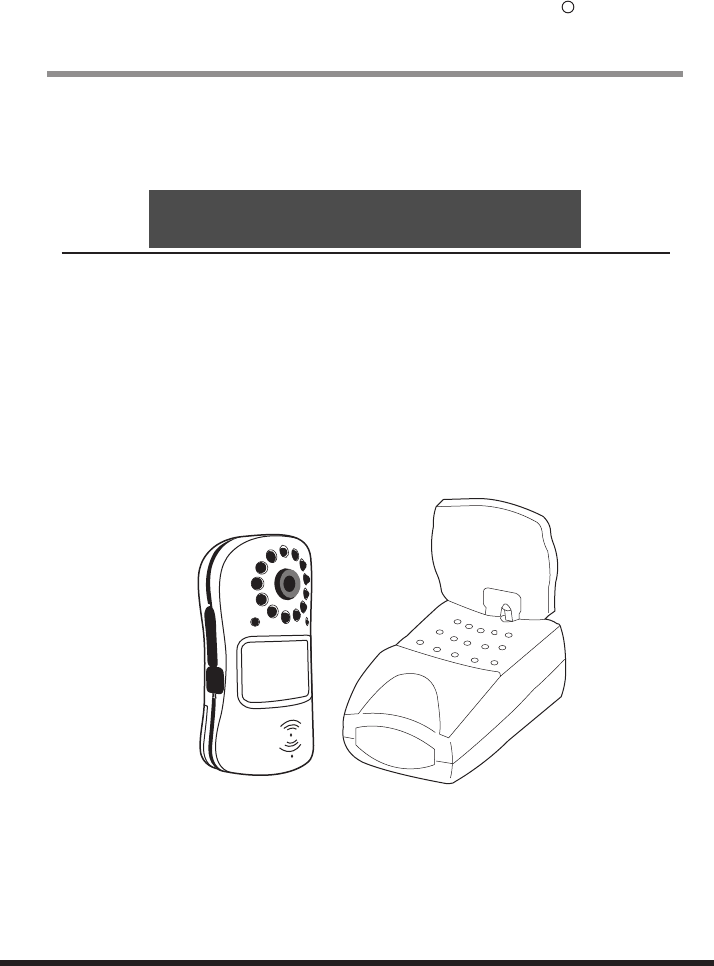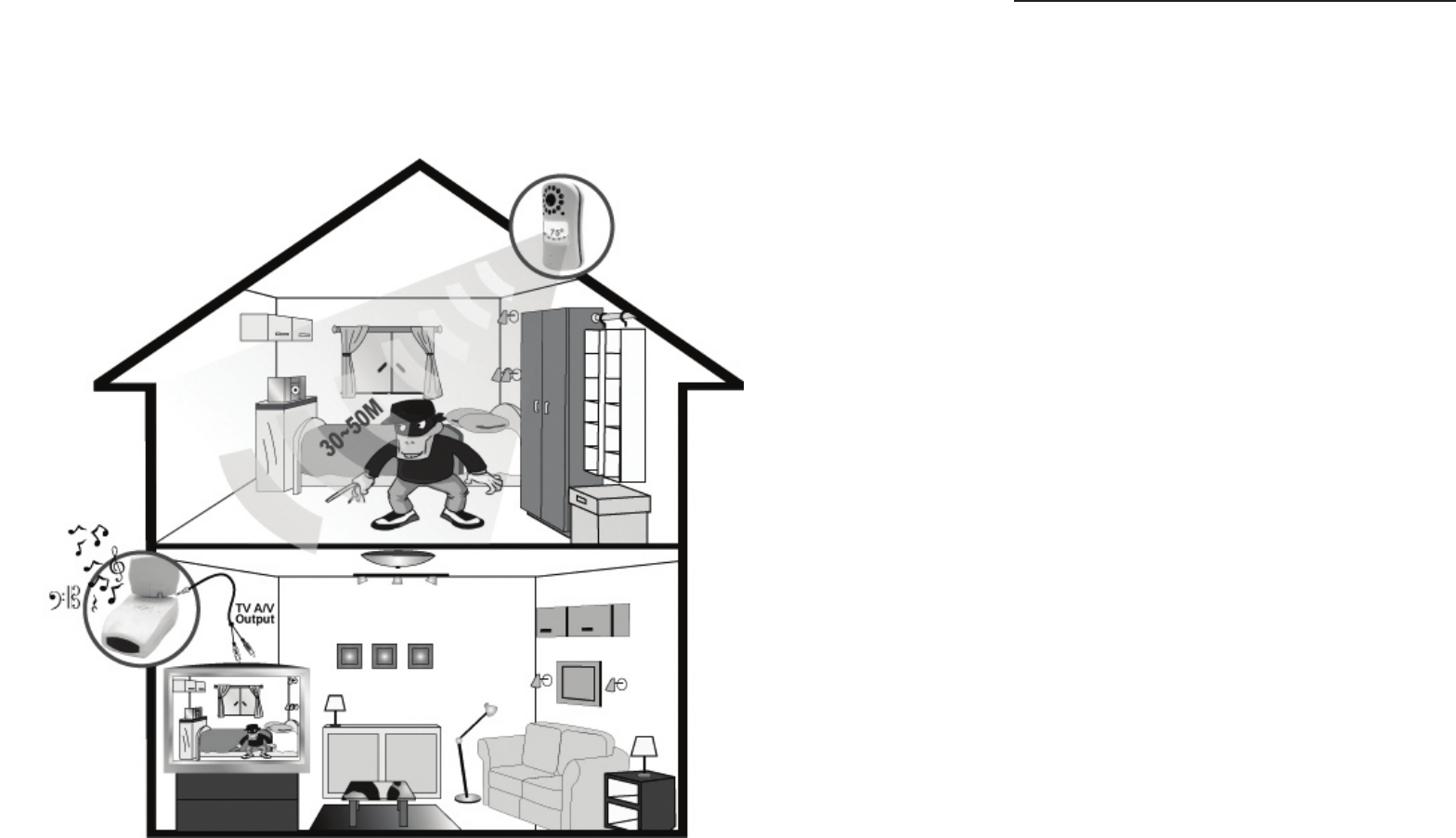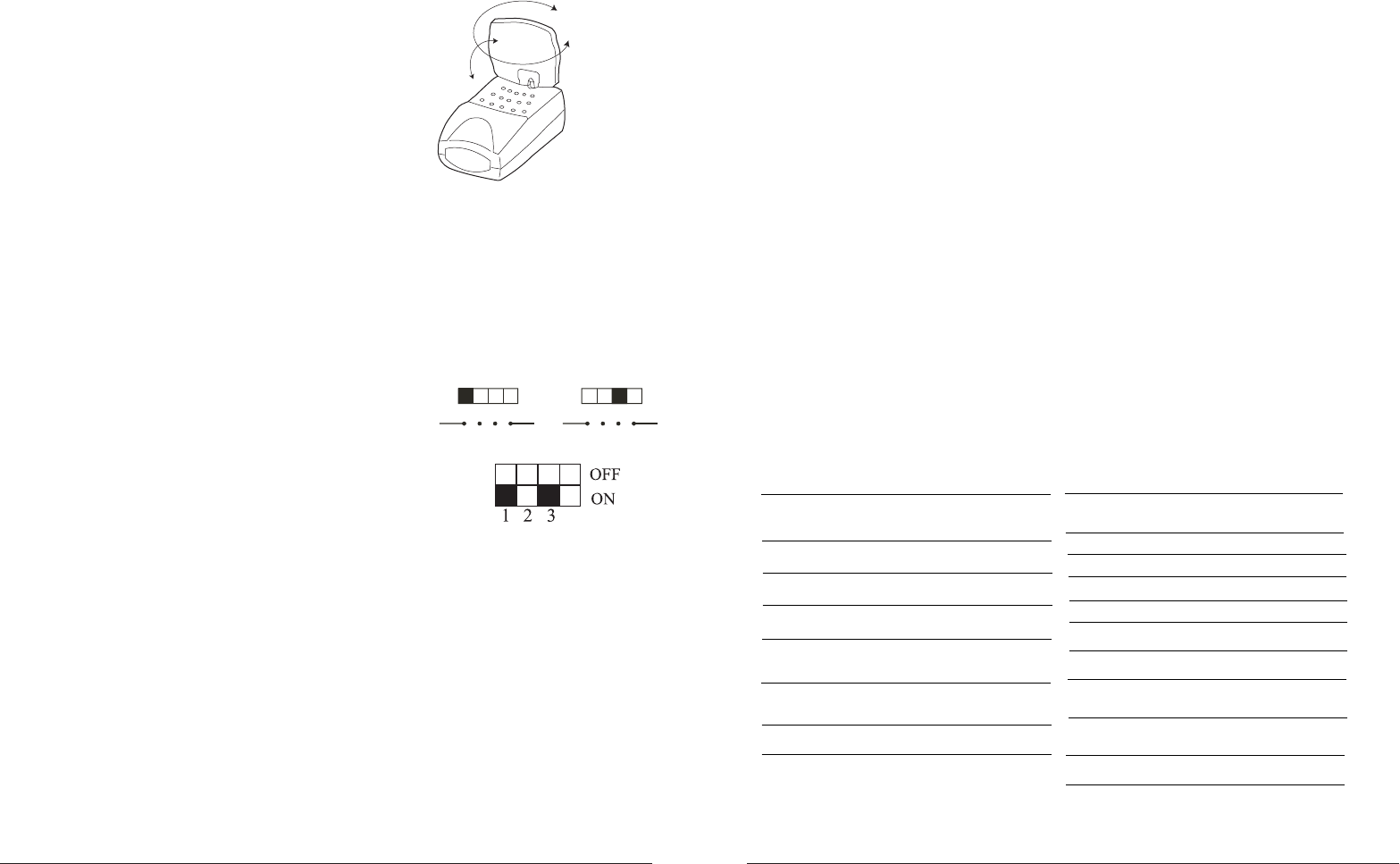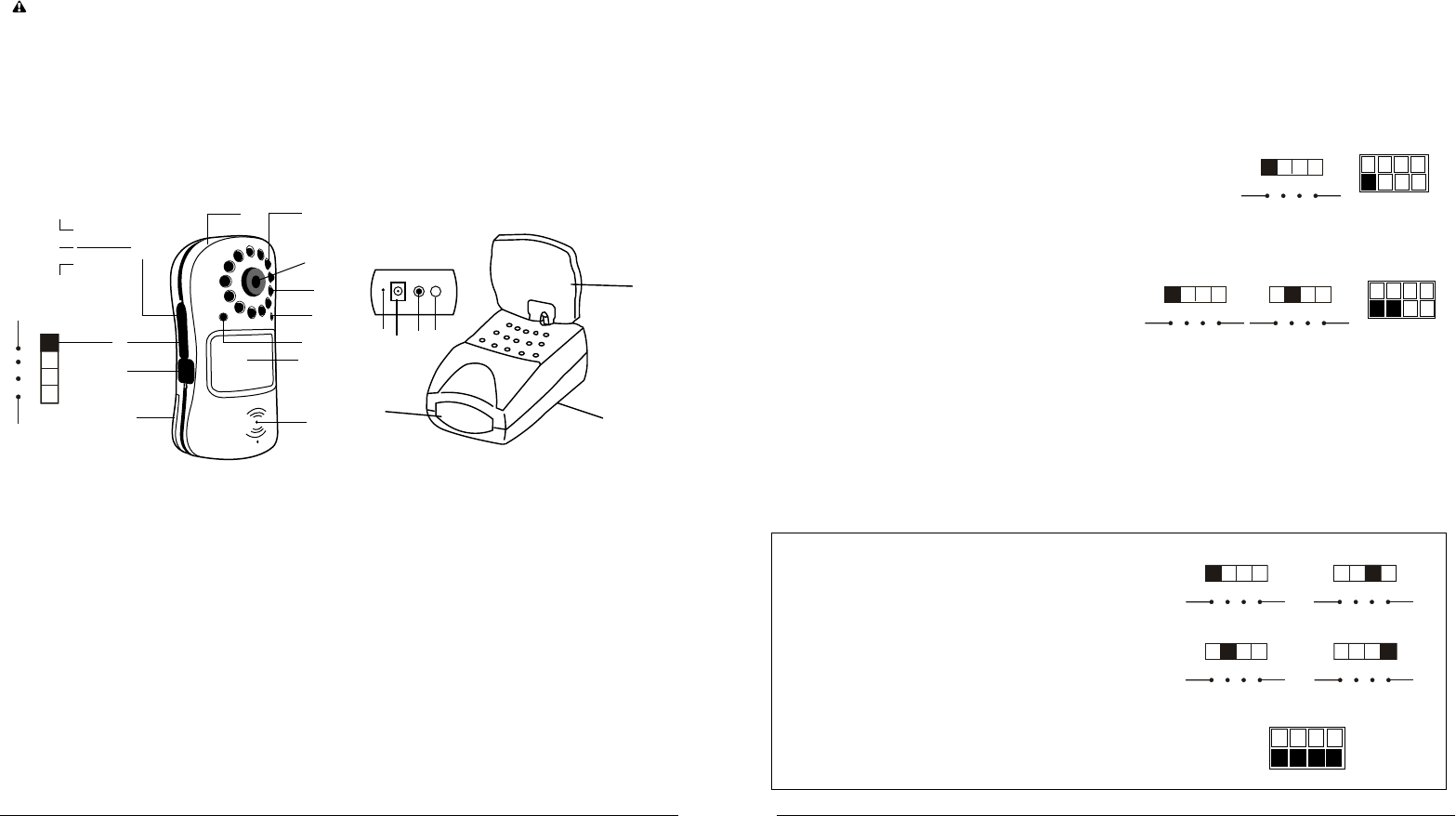JSW Pacific CCD-413S Wireless PIR Camera User Manual UserManual 6200 Cover ai
JSW Pacific Corporation Wireless PIR Camera UserManual 6200 Cover ai
Users Manual

User's Manual
Model No.: CCD-413
Wireless Weatherproof IP44 PIR
Sensor Camera
- Receiver with Patch Antenna
- 2.4GHz Wireless Camera with PIR Sensor LED
PLEASE READ CAREFULLY AND SAVE
This manual contains important information about this product's operation.
If you are installing this product for use by others you must leave this
manual -or a copy- with the end user.
Navigator R

Important!
Please read this booklet carefully
before installing or using these units.
DANGER- HIGH VOLTAGE- These units
should ONLY be opened by an authorized
technician if service is required.
Safety Precautions
For correct and safe operation of this
system, it is essential that installers, end-
users and service technicians should follow
all safety procedures outlined in this
manual. Specific Warning and Caution
statements (and/or symbols) are marked on
the units where needed.
Warning and Caution Statements
"WARNING" indicates a situation where
failure to follow proper procedures can
cause personal injury.
"CAUTION" indicates a situation where
failure to follow proper procedures can
cause damage to the equipment.
Federal Communication Commission Interference Statement
This equipment has been tested and found to comply with the limits for a Class B digital device,
pursuant to Part 15 of the FCC Rules. These limits are designed to provide reasonable protection
against harmful interference in a residential installation.
This equipment generates, uses and can radiate radio frequency energy and, if not installed and
used in accordance with the instructions, may cause harmful interference to radio communications.
However, there is no guarantee that interference will not occur in a particular installation. If this
equipment does cause harmful interference to radio or television reception, which can be determined
by turning the equipment off and on, the user is encouraged to try to correct the interference by one
of the following measures:
. Reorient or relocate the receiving antenna.
. Increase the separation between the equipment and receiver.
. Connect the equipment into an outlet on a circuit different from that to which the receiver is connected.
. Consult the dealer or an experienced radio/TV technician for help.
FCC Caution :To assure continued compliance, any changes or modifications not expressly approved
by the party responsible for compliance could void the user's authority to operate this equipment.
(Example - use only shielded interface cables when connecting to computer or peripheral devices).
This device complies with Part 15 of the FCC Rules. Operation is subject to the following
two conditions:
(1) This device may not cause harmful interference, and
(2) This device must accept any interference received, including interference
that may cause undesired operation.

Model No.: CCD-413
Wireless Weatherproof IP44 PIR Sensor Camera
Model No.: CCD-413
Wireless Weatherproof IP44 PIR Sensor Camera Contents
Important Safety Precautions ..................................1
Specifications ............................................................2
Parts Included with This System .............................3
Parts of the Wireless PIR Pinhole Color Camera.....3
- Parts of the Camera ...............................................3
- Parts of the Receiver .............................................3
Installation .................................................................4
- Installing the Wireless PIR Pinhole Color Camera...4
Rotating the Antenna for Best Performance.........5
Auto-Sequence Function ..........................................5
Troubleshooting Guide .............................................6
Warranty .....................................................................6

Important Safety Precautions
Please read before Installing
Congratulations on your purchase of the 2.4GHz Wireless Color Monitoring System. Please read these
safety and operating instructions carefully before installing and using this system.
- Keep the camera, receiver and AC/DC adapter cord out of reach of children.
- Do not place the camera, receiver or AC/DC adapter cord in a crib or playpen.
- Do not use the camera near water or damp and wet environments, such as a bathtub, laundry tub,
kitchen sink, or wet basements.
- Locate the camera, receiver and AC/DC adapter where there is adequate ventilation. Do not locate
the camera in direct sunlight.
- Do not locate the camera, receiver and AC/DC adapter near heat sources such as heat registers,
radiators, ovens, furnaces or other appliances with high operating temperatures.
- Do not use with extension cords. Use only the AC/DC adapter provided with this system. Use of
other adapters may damage the camera or receiver and void your warranty.
- Only plug components into standard household voltage outlets (110V - 240V AC, 50Hz or 60 Hz).
- Do not place cords from the AC/DC adapters, camera or receiver where they can be pinched or
stepped on. Protect the cords by keeping them out of the way of children, pets and routine
household traffic. Do not place heavy objects on power cords or cover cords with rugs or carpet.
- When cleaning, use a DRY, lint-free cloth. Unplug the camera, receiver and AC/DC adapter before
cleaning. NEVER immerse any components in water and do not spray cleaners or solvents on the
unit. Doing so may damage the unit or cause electrical shock.
- Unplug the AC/DC adapter from the wall outlet when the system is not in use.
- Mishandling, alterations or modifications not approved by the manufacturer will void the warranty.
CAUTION!
- Connect this unit ONLY to other compatible units. Do not connect it to any other type of alarm or
auxiliary device. Connecting anything else to this unit may damage it or prevent it from operating
properly.
CAUTION!
- Do not paint over the camera.
CAUTION!
- This system uses public airwaves for wireless operation. The sound and video may be broadcast
to and picked up by other 2.4 GHz receiving devices. Conversations and images from other rooms
near the camera may be broadcast and picked up. To protect your privacy, always turn the camera
off when not in use.
Additional Notice- Do not place video monitor or equipment on an unstable cart, stand or table. The
video monitor or equipment may fall causing serious injury to a child or adult.
1
You should...
1. Check that the power cord(s) is properly connected.
2. Check that the monitor is turned ON.
3. Wrong AC/DC adapter used. Check that the adapter labeled
OUTPUT: 7.5V DC is connected to the camera, and adapter
labeled OUTPUT: 10V DC is connected to the receiver.
1. Check the channel switch settings on the camera(s) and
receiver. Make sure the channels match on both units.
2. Signal interference from a microwave oven. Check if a
micro-wave oven is in use or located in the path between
the camera and receiver. If so, turn it off or move it out of
the path.
3. Signal interference from other signal producing devices.
(a) Change the channel setting on both camera and receiver.
(b) Identify and eliminate the source of the interference.
(c) Relocate the camera and/or receiver closer to each other.
4. Camera and receiver are too far apart. Relocate the camera
closer to the receiver.
5. Antenna is positioned improperly. Adjust the antenna on the
camera and/or receiver.
Troubleshooting Guide
If the Camera
and/or Monitor...
No Power
No sound or picture.
Distorted sound or
picture
6
1 Year Limited Warranty:
JSW Pacific Corp., the maker of Navigator brand products, warrants that for a period of 1 year from
the date of purchase, this product will be free from defects in material and workmanship. JSW, at its
option, will repair or replace this product or any component of the product found to be defective during
the warranty period. Replacement will be made with a new or remanufactured product or component.
If the product is no longer available, replacement may be made with a similar product of equal or
greater value. This is your exclusive warranty.
This warranty is valid for the original purchaser from the
date of initial purchase with JSW and is not transferable.
This warranty does not cover normal wear of
parts or damage resulting from any of the following: negligent use or misuse of the product, use on
improper voltage or current, use contrary to the operating instructions, disassembly, repair or alteration
by anyone other than JSW or an authorized service center. Further, the warranty does not cover acts
of God, such as fire, flood, hurricanes and tornadoes or any batteries that are included with this unit.
JSW
shall not be liable for any incidental or consequential damages caused by the breach of any
express or implied warranty.

5 2
FCC/CE WARNING
This equipment generates and uses radio frequency energy and if not installed and used properly,
that is, in strict accordance with the manufacture's instructions, may cause interference to radio and
television reception. It has been tested and found to comply with limits for a Class B digital device in
accordance with Part 15 of FCC Rules and CE I-ETS 300 440, which are designed to provide
reasonable protection against such interference in a residential installation. However, there is no
guarantee that interference will not occur in a particular installation. If this equipment does cause
interference to radio or television reception, which can be determined by turning the equipment off
and on, the user is encouraged to try to correct the interference by one or more of the following
measures:
1. Reorient the TV/radio antenna.
2. Relocate the Receiver away from the TV/radio receiver.
3. Plug the Receiver into a different wall outlet so that the Receiver is on a different branch circuit.
4. If necessary, the user should consult the dealer or an experienced radio/television technician for
additional suggestions.
The user may find the following booklet prepared by the Federal Communication Commission helpful:
"How to Identify and Resolve TV Interference Problems." This booklet is available from the US
Government Printing Office, Washington, D.C. 20402, Stock No. 004-000-00345-4.
FCC/CE NOTICE
The user is cautioned that changes or modifications not expressly approved by the manufacturer
could void the user's authority to operate the equipment. Linear radio controls provide a reliable
communications link and fill an important need in portable wireless signaling. However, there are
some limitations which must be observed.
The radios are required to comply with FCC Rules and Regulations as Part 15 devices and CE I-ETS
300 440. As such, they have limited transmitter power and therefore limited range. A receiver cannot
respond to more than one transmitted signal at a time and may be blocked by radio signals that occur
on or near their operating frequencies. Changes or modifications to the device may void FCC and CE
compliance. Infrequently used radio links should be tested regularly to protect against undetected
interference or fault.
Rotating the Antennas for Best Performance
This system broadcasts its high-quality audio and video using directional antenna. The
antenna can rotate in either clockwise or counterclockwise
directions to obtain the best signal and picture
clarity. In most situations, additional adjusting of
the antenna may be necessary to get optimal
performance. If the camera and receiver are less than
10 feet apart, leave the antenna in the closed (down)
position. See the instructions shown on the right to
rotate the antenna.
The Auto Sequence Feature
The Wireless Color Monitoring System can be set up to monitor a series of rooms in a
home or office. The receiver can connect up to three cameras on three different channels for
both Audio/Video reception, and display them in auto sequence. The system has dip-switches
for 4 channels to allow various monitoring options.
When the channel dip-switches are set in the "ON" position, that channel is active on the receiver
and can be seen on the TV or monitor. Channel dip-switches in the "OFF" position are inactive
and will not be shown on the TV or monitor.
The auto-sequence feature is activated when more than one
channel is switched ON. The channels switched ON will display
on the TV or monitor at three second intervals. For example,
if you have two cameras, one set to Channel 1 and the other
set to channel 3, the dip-switch on the receiver must be set for
both channels 1 and 3. Then camera one [CH1] and camera
two [CH3] will start to display on the TV or monitor in sequence
at three seconds intervals. This interval time is preset by the
factory and cannot be adjusted by the user.
To stop the auto-sequence function:
Slide the dip-switch of the channel(s) you do not want displayed
to OFF on both that camera and the receiver. Channels in the
OFF position will no longer be displayed.
270º
Up/Down 84º
Receiver
Channel Dip-Switch
Diagram Channels 1 & 3 ON
4
Specifications
RECEIVER:
RECEIVING DISTANCE Up to 300 Feet
(Clear Line of Sight)
VIDEO OUT 1 Vp-p 75 Ohm
AUDIO OUT 1 Vp-p 600 Ohm
POWER SUPPLY 10V / 600mA Adapter
OPERATING TEMP. 14°F - 122°F
-10°C - 50°C
WEIGHT 209g
CAMERA:
IMAGE SENSOR 1/3" Color CMOS
Image Sensor
RESOLUTION 330 Horizontal TV Lines
LENS 6mm
OPERATING TEMP. 14°F - 122°F
-10°C - 50°C
DIMENSIONS 120 x 65.5 x 38 mm
WEIGHT 170g
DIMENSIONS 95x 47 x 63 mm
POWER SUPPLY 7.5V / 500mA Adapter
PIR Viewing Angle > 75°
PIR Viewing Distance >5m
ON
CH1
C
C
a
a
m
mera
1
1
ON
Camera 3
CH3
CH 1 2 3 4 CH 1 2 3 4
ILLUMINATION < 3 Lux

3 4
Parts Included with This System
- Camera with Built-In Transmitter
- 2.4 GHz Receiver
- 7.5V AC/DC Adapter for the Camera
- 10V AC/DC Adapter for the Receiver
- A/V Cable
WARNING!
This system includes two AC/DC adapters with different voltage. Use the adapter labeled OUTPUT:
7.5V DC for the camera only. The adapter labeled OUTPUT : 10V DC is for use with the receiver only
.
The AC/DC adapters are not interchangeable.
Parts of the Wireless PIR Pinhole Color Camera
Parts of the Receiver
1. Antenna
2. Channel LED
3.
Power LED
4. 10V DC Input Jack
5.
Video Output Jack
6. Audio Output Jack
7 . Channel Switch
1
5
4
3
7
(On the bottom)
Rear View
2
(Inside)
ON
1 2 3
ON
1 2 3
Camera Set to
Channel 1
Camera 1
Set to
Channel 1
Camera 2
Set to
Channel 2
Receiver Set
to Channel
1 & 2
Receiver Set to
Channel 1
ON
CH1
C
C
a
a
m
mera
1
1
ON
Camera 2
ON
Camera 3
1 2 3
ON
Receiver
CH2
CH3
Installing the Wireless PIR Pinhole Color Camera
To install the system, follow these steps:
Receiver:
1. Plug the AC/DC adapter cord into the DC input jack on the back of the receiver.
2. Plug the audio/video cord to the anuio/video output jack of the receiver. Plug the other end of the cord
to the audio/video input jacks on your TV or monitor.
3. Plug the 10V AC/DC adapter into a standard (110V-240V) outlet. The power indicator LED
located on the top of the receiver should light.
Camera:
1. Plug the 7.5V DC adapter cord into the DC input jack on the back of the
camera.
2. Plug the adapter into a standard (110V-240V) AC outlet. The power indicator LED should light.
System Setup:
1. Select the channel (Channel 1-4) to be used on both the camera and receiver.
NOTE: Make sure the camera and receiver are set to the same channel (1, 2 or 3,4).
2. Set the selected channel by gently pushing the dip-switch for that channel to the ON position on
both the camera and the receiver.
For example, to set both the camera and receiver on Channel 1:
(a) Push the Channel 1 dip-switch located on the bottom of
the camera and the receiver to the ON position.
(b) Make sure the remaining dip-switches are in the OFF
position. In this case, channels 2 and 3/4 should be in
the OFF position.
If more than one camera is to be installed and operated at the same time:
Simply follow steps (a) and (b) and set the
dip-switches for the other channels on the
camera and receiver to ON.
For example, to operate two cameras: set
Camera 1 to Channel 1 (other channels off),
set Camera 2 to Channel 2 (other channels off),
and on the receiver, set channels 1 and 2 to ON.
See “Camera and Receiver Setting Chart” below for more detailed instructions.
3. Position the camera antenna toward the receiver antenna. Rotate/adjust the antennas on both the
camera and receiver for best performance.
Additional Notice- When installing the camera, check the reception of the receiver before final
installation. Have someone hold the camera in the area to be monitored and another person to check
the reception with your TV or monitor. If interference or other problems occur, refer to the
Troubleshooting Guide.
Camera & Receiver Channel Setting Chart
1. This 2.4 GHz system can be connected with up to 4
channels. Set channels on the camera and receiver
before starting the system.
2. Set camera and receiver channels by gently pushing the
switches with an object such as a pen or pencil to the ON
or OFF position. Use the illustrations shown on the right
as a guide. The switches are inset into the camera and
receiver housings to avoid accidentally changing the
channel settings.
3. The Auto Sequential Scanning feature automatically
activates when more than one switch is set to ON.
6
4
4
4
ON
CH4
Camera 4
CH 1 2 3 4
CH 1 2 3 4 CH 1 2 3 4
CH 1 2 3 4
CH 1 2 3 4
CH 1 2 3 4
CH 1 2 3 4
Parts of the Camera
1. Camera Lens
2. Power LED
3. Low Battery LED
4. Built-in Antenna
5. PIR Sensor
6. 7.5V DC Input Jack
7. Channel Switch
8. Microphone
9. Battery Chassis (AAA x 4 pcs )
10. Power OFF / Power ON / PIR OFF
11. CDS Auto Controlfor Night Vision
12. 12 IR LED
CH 1 2 3 4
1
4
6
9
7
5
2
8
12
10
11
3
Power
OFF
PIR
OFF
Power
ON